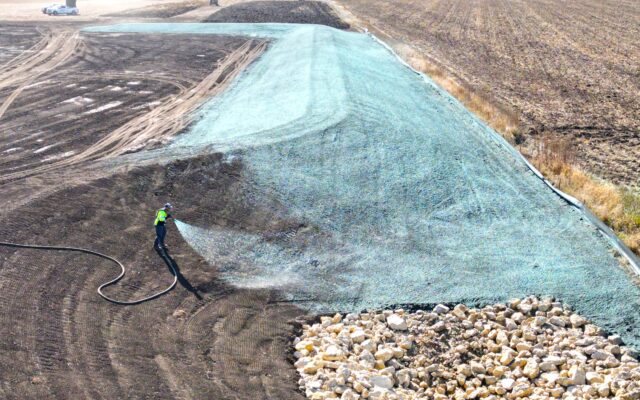Half-mile of berms now in place for Dobbins Creek

Five miles east of Austin, two berms spanning a combined half-mile are ready to capture large amounts of stormwater and snowmelt in the watershed of Dobbins Creek’s south branch.

Last week, crews sprayed Hydromulch to help spur vegetation on the earthen berms that will play a big role in reducing flooding and improving water quality in rural areas, the City of Austin and East Side Lake, which is created by a dam on Dobbins Creek. Overall, 467 acres of mostly cropland now will drain to the new berms that will treat and temporarily store stormwater before releasing it downstream.
With these berms, the peak flows will be about 14 percent lower at East Side Lake when the area experiences a 100-year rain event, which has about 1 percent chance of happening each year.
That’s particularly important in a watershed like Dobbins that is known for flash floods, said Cody Fox, administrator and project manager for the Cedar River Watershed District. These berms decrease the amount and speed of stormwater flow in the watershed, reducing the risks for overtopped roads and the potential for major streambank erosion, he said.
CRWD led the nearly $800,000 project on cropland owned by farmer Al Akkerman in Red Rock Township, just north of Interstate 90 and east of Mower County Road 19, which has overtopped with stormwater at times. Costs came in about $200,000 less than budgeted for the project.
Part of CRWD’s Capital Improvement Plan (CIP) started in 2016, they are the first CIP structures built since 2020 when CRWD led a $1.2 million project that created a nearly 2,000-foot-long berm with a 21-foot peak height in Dexter Township also in Dobbins’ south branch headwaters.
CRWD now has built four CIP berms in five years by working with the Akkerman family in the Dobbins watershed.
About 60 percent of the funding came from the state’s Clean Water Fund, with the rest mostly covered by a grant from The Hormel Foundation in Austin. A small portion is funded by a federal Environmental Protection Agency grant.
Houston Engineering designed the project, and Hodgman Drainage built the berms that measure 1,250 feet and 1,500 feet long with peak heights of 10 and 12 feet, respectively.
To date, CRWD has 13 upland-storage projects built in the headwaters areas of Dobbins Creek’s north and south branches.
Overall, these berms treat stormwater flowing from 3,967 acres or nearly 6.2 square miles of mostly cropland. Together, the CIP berms can hold up to 410 million gallons of stormwater when levels reach each berm’s spillway. For perspective, Austin’s west-side water tower can hold 1 million gallons of water.
With upland storage, much of the sediment, excess nutrients and other pollutants in stormwater settles to the bottom of the basin behind the berms rather than continue into Dobbins Creek, East Side Lake and the Cedar River State Water Trail, which meets Dobbins in Austin’s Driesner Park.
CRWD staff are hopeful that additional upland-storage work will happen in 2024 in the Dobbins watershed.







